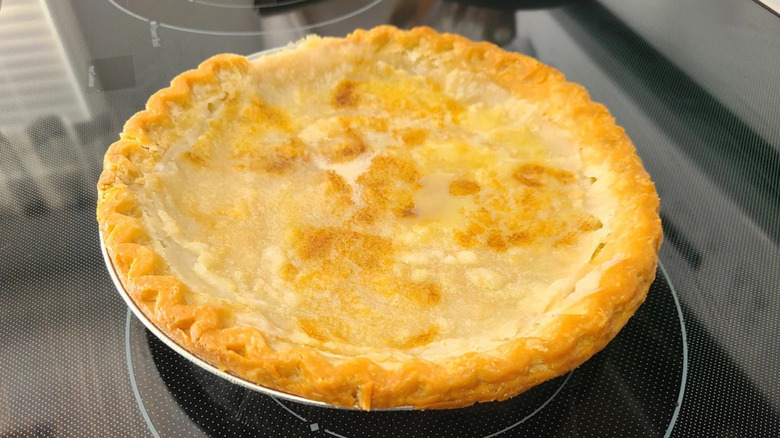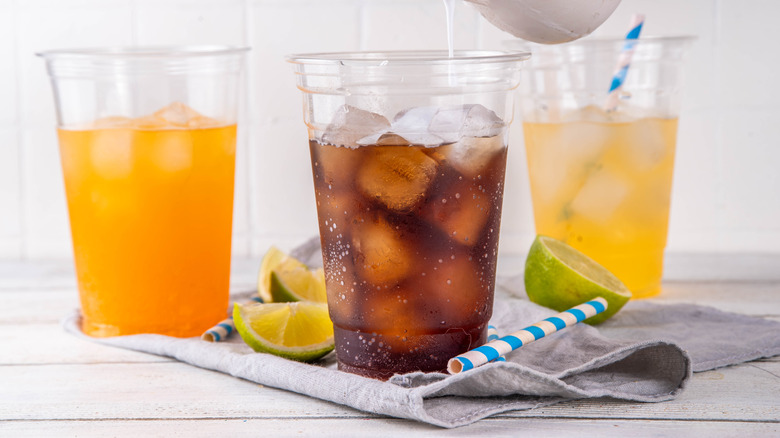Upgrade Depression-Era Water Pie With A Fizzy Alternative
During the Depression era, when times were tough and every ingredient had to stretch, baked goods became a testament to creativity born out of necessity. With staples like fruit, eggs, and dairy often out of reach, home cooks devised clever substitutions to still enjoy dessert. There was mock apple pie, which skips pricey apples for crackers boiled in sugar and spices, or chocolate cake made without eggs, milk, or butter, and perhaps most surprising of all: Water pie – which can be prepped in a matter of seconds. And don't let the name fool you — this 1930s favorite is full of flavor. To learn more about this classic and how to give it a modern twist using soda, Food Republic spoke with Walleska Cianfanelli, executive pastry chef and culinary education lead at Wilton's Sweet Studio.
Unlike traditional custard pies, which rely on eggs and milk for structure, water pie uses plain water as its wet ingredient. "As it bakes, the flour and sugar combine with the water to create a silky custard filling," Cianfanelli explained. It's described as sweet – with the topping not too distinct from a classic custard.
But water can only go so far as a flavor enhancer. To level up your pie, Cianfanelli suggested substituting water for soda. "Cola or root beer adds notes of caramel, vanilla, and spice, giving the pie a richer taste," she told us. "Fruity sodas (like orange or lemon-lime) make the pie brighter and more candy-like, sometimes reminiscent of a creamsicle or sherbet." Beyond flavor, Cianfanelli also noted that soda transforms the pie's texture thanks to two ingredients that are plentiful in pop: carbon dioxide and sugar. The former aerates the batter, while the latter deepens caramelization during baking.
Do certain sodas that work better than others?
No two sodas are the same, and each one will affect your water pie differently. According to Walleska Cianfanelli, certain sodas are, in fact, better suited for this dessert. "This is determined by how the soda's acidity, sugar content, and flavor interact with the pie's thickener or flour," she explained.
Generally speaking, soda is on the more acidic side. But if the soda's too acidic, it can interfere with starches, weakening their ability to thicken properly. This means it's best to avoid super acid-heavy sodas, like Coca-Cola, which contains phosphoric acid. Instead, Cianfanelli recommends looking for sodas containing citric acid, which "brightens the flavor without breaking the starch gel." Citric acid is milder than phosphoric acid but stronger than the flavorless carbonic acid found in soda water, so it hits the perfect balance of structure and flavor.
Another factor to keep in mind is the color of the soda. "Clear, citrus sodas (like Sprite, 7UP, Sierra Mist) work better for making the pie," Cianfanelli told us. "The neutral color that will keep the filling light and golden." Darker or intensely artificially colored sodas like Mountain Dew, Fanta, or Crush can technically work as a substitute, but they may leave your pie looking less appetizing. According to Cianfanelli, "Sprite gives the most 'classic' feel: light and lemony with a custard taste," which is why it is also a great addition for extra flavorful pound cakes and helps explain the growing trend of 7UP cakes.


